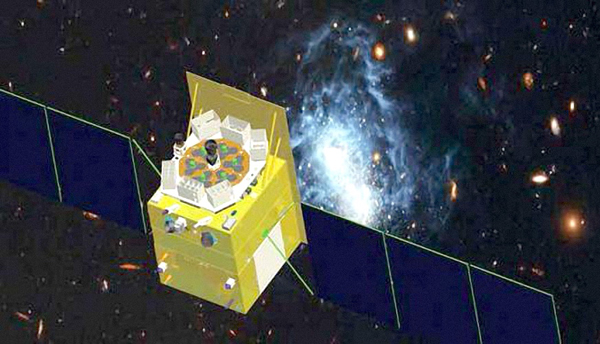Telescope looks for ripples in space
 |
|
Artist's rendering of the HXMT telescope. Provided To China Daily |
Since the detection of gravitational waves, scientists have been eager to find electromagnetic signals corresponding to them. This will be an important task for China's space telescope, the Hard X-ray Modulation Telescope, which will be launched soon.
Gravitational waves are "ripples" in the fabric of space-time caused by some of the most violent and energetic processes in the universe. Albert Einstein predicted their existence in 1916, saying that massive accelerating objects, such as neutron stars or black holes orbiting each other, would disrupt space-time in such a way that "waves" of distorted space would radiate from the source, like ripples away from a stone thrown into a pond.
These ripples would travel at the speed of light through the universe, carrying with them information about their origins and invaluable clues to the nature of gravity itself.
In February 2016, the Laser Interferometer Gravitational-Wave Observatory (LIGO) in the United States announced the first observation of the phenomenon. It was the first direct detection of a binary black hole merger.
Xiong Shaolin, a scientist at the Institute of High Energy Physics of the Chinese Academy of Sciences, said the positional accuracy of all gravitational wave events detected so far is still very poor.
If scientists can find electromagnetic signals happening at similar positions and times of the gravitational wave events, it will increase the reliability of the detection. Combined analyses of the gravitational wave and electromagnetic signals will help reveal more about the celestial bodies emitting the waves, Xiong said.
Scientists have yet to detect electromagnetic signals corresponding to gravitational waves.
Many scientists would regard detecting gravitational waves and corresponding electromagnetic signals as a major scientific discovery. Some suspect that mysterious gamma ray bursts could be exactly that.
Gamma ray bursts are extremely energetic explosions that have been observed in distant galaxies. They are the brightest electromagnetic events known in the universe.
About 0.4 seconds after the first gravitational event was detected on Sept 14, 2015, NASA's Fermi Gamma Ray Space Telescope detected a relatively weak gamma ray burst, which lasted about one second.
But scientists disagree on whether these two events are related, and no other probe has detected such a burst.
"We are not clear about many details of gamma ray bursts. For instance, how energy is released during a gamma ray burst," said Zhang Shuangnan, lead scientist of the Hard X-ray Modulation Telescope and director of the Key Laboratory of Particle Astrophysics of the Chinese Academy of Sciences.
"Since gravitational waves were detected, the study of gamma ray bursts has become more important. In astrophysics research, it's insufficient to study just the gravitational wave signals. We need to use the corresponding electromagnetic signals, which are more familiar to astronomers, to facilitate the research on gravitational waves," Zhang said.
The Hard X-ray Modulation Telescope's effective detection area for monitoring gamma ray bursts is 10 times that of the Fermi space telescope. Scientists estimate that it could detect almost 200 gamma ray burst events every year.
"It can play a vital role in searching for electromagnetic signals corresponding to gravitational waves," Zhang said. "If it can detect them, it would be its most wonderful scientific finding."
However, Zhang adds, if it cannot detect any gamma ray bursts related to gravitational waves, it may mean the model suggesting gravitational waves can generate such bursts is wrong.
Xiong says all the gravitational waves detected by LIGO were caused by mergers of black holes, which many scientists believe cannot generate electromagnetic signals. After the sensitivity of the observatory is improved in 2020, it is expected to be able to detect gravitational waves caused by mergers of two neutron stars, which could possibly generate gamma ray bursts.




















